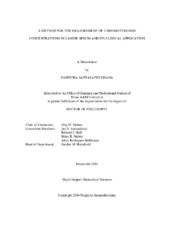| dc.description.abstract | The eosinophil count in the peripheral blood does not accurately represent eosinophil activation in tissues, as eosinophils primarily reside in tissues and not in peripheral blood. To date, a non-invasive biomarker for eosinophil activation in dogs has not yet been described. Therefore, the aims of this study were to (1) develop and analytically validate an electron ionization gas chromatography/mass spectrometry (EI-GC/MS) method to identify and measure 3-Bromotyrosine (3-BrY) concentrations in canine serum, (2) establish a reference interval for serum 3-BrY concentrations in healthy pet dogs, (3) determine the short-term stability of canine serum 3-BrY concentrations, and (4) evaluate the clinical usefulness of measuring 3-BrY concentrations in canine serum.
Left-over serum samples from dogs were used to analytically validate the assay. Serum samples from 41 healthy dogs were used to establish a reference interval. A stable isotope of 3-BrY, D3-bromotyrosine, was produced in house and added to canine serum samples. 3-BrY in serum samples was extracted and detected by solid-phase extraction and EI-GC/MS, respectively. Limit of blank and limit of detection were 0.33 and 0.63 μmol/L, respectively. Coefficients of variation for precision and reproducibility of the 3-BrY concentrations were <13.9% and <11.0%, respectively. Linearity and accuracy recoveries ranged from 84.0% to 134.4% and 79.1% to 126.7%, respectively. The reference interval was determined to be ≤1.12 μmol/L. Serum 3-BrY concentrations were stable for ≤8, 30, and 180 days at 4°C, -20°C, and -80°C, respectively.
To evaluate the clinical usefulness of 3-BrY concentrations in canine serum, samples were collected from healthy dogs, dogs with eosinophilia, dogs with eosinophilic gastroenteritis (EGE), dogs with lymphoplasmacytic enteritis (LPE), dogs with exocrine pancreatic insufficiency, and dogs with pancreatitis. Concentrations of 3-BrY in the serum samples were significantly higher in dogs with eosinophilia, dogs with EGE, dogs with LPE, dogs with pancreatitis compared to healthy control dogs (P<0.0001).
In conclusion, the newly developed method for the measurement of 3-BrY concentrations in canine serum samples was precise, reproducible, linear, accurate, and stable. Moreover, serum 3-BrY concentrations may serve as a potential diagnostic marker for dogs with chronic enteropathy after the exclusion of pancreatitis. | en |


